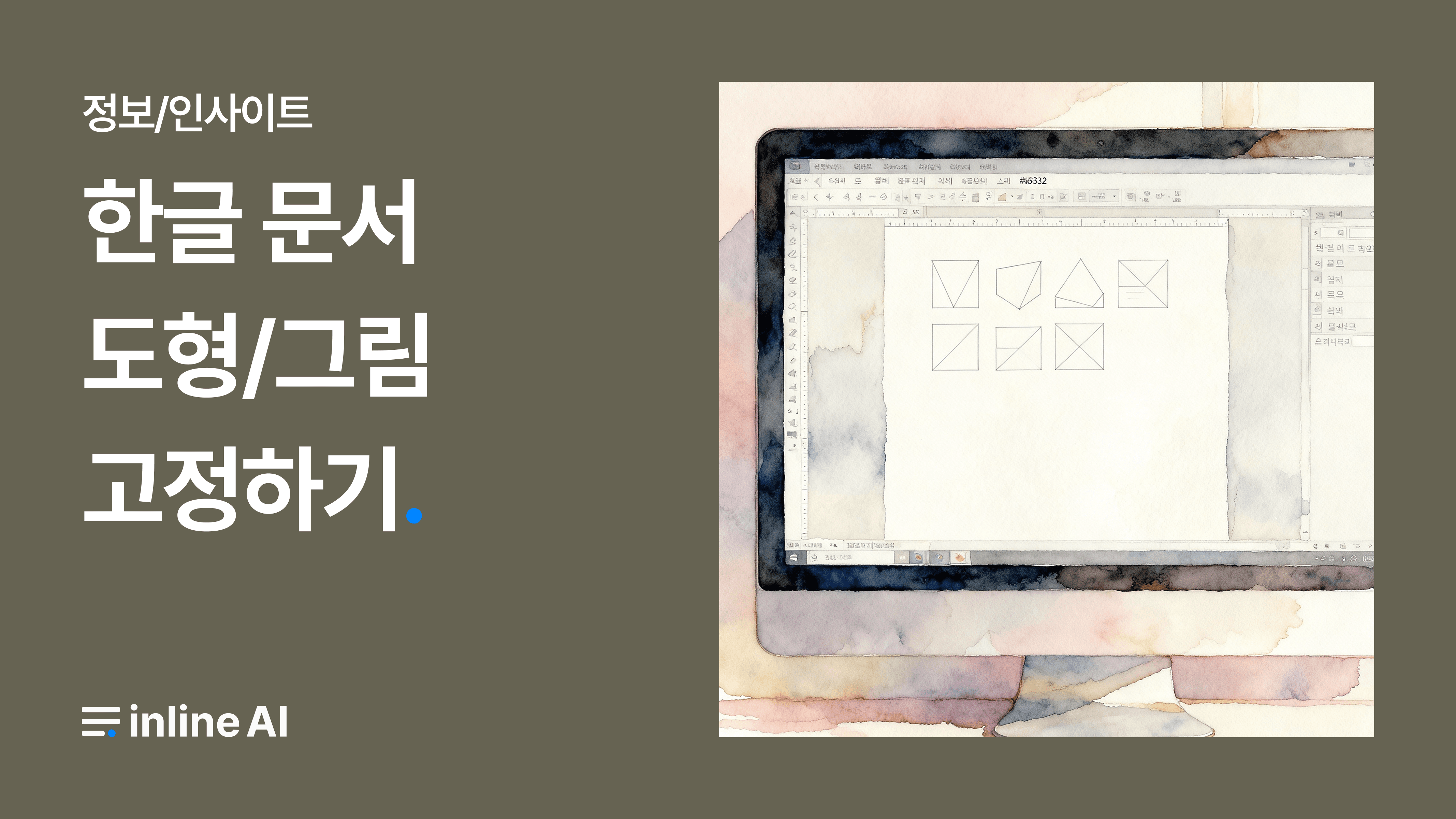Have you ever struggled with plain-looking titles while creating a report using Hangul files?
You might have wanted to add colors or decorate the borders of the title but were unsure of how to proceed.
Professionally embellishing titles in Hangul editor is simpler than you might think.
By using text boxes and tables, you can create various Hangul title designs such as titles with rounded corners or titles with specific highlighted borders. Understanding the characteristics of each tool allows you to complete your Hangul report in your desired style.
This guide explains step-by-step how to set up Hangul titles using text boxes and tables.
Gain all the know-how to decorate Hangul titles.

Text Box vs. Table: Which Tool Should You Choose?
There are two methods for designing Hangul titles: utilizing text boxes and tables.
Before diving into the Hangul title design methods, it's essential to understand the differences between the two tools.
Text boxes and tables each have unique pros and cons, and your choice should be made depending on your desired design.
When to Use Text Box Titles
If you want to round the corners of the title border, apply shadow effects, or if the overall visual effect is fundamental to the Hangul title design, it is recommended to use text boxes.
However, text boxes do not allow for removing or setting different thicknesses for specific border directions, and fine-tuning of borders is challenging.
When to Use a Table (1 row, 1 column) Title
If you want to emphasize or remove specific borders or set up a Hangul title line with a thick bottom border, creating a table (1 row, 1 column) is a good option. With this, you can hide side borders and achieve a sleek design.
However, tables cannot have rounded corners, and shadow effects cannot be applied.
👉 Explore Everything About Hangul Table Editing - Passing Tables, Solving Table Overflows, Dividing Tables
Case 1: Creating Hangul Titles with a Text Box
The text box is the most suitable tool in an HWP document when creating titles with rounded corners or shadow effects. It is an essential feature for enhancing the professionalism of Hangul reports.
How to Create a Hangul Title Text Box

Select 'Shape' from the 'Insert' menu → choose 'Horizontal Text Box' among the 'Drawing Objects'.
Draw the text box according to the page width.
Select the text box and press shortcut key P or double-click to open the 'Object Properties' dialog box.
You can also create a text box by pressing the shortcut keys (Ctrl+N+B) in sequence.
Have you seen these shortcut methods for the first time just now? After reading this article, continue to check the link below.
👉 Download the Hangul Shortcut Tips PDF
How to Change the Text Box Size

Right-click the text box to bring up the 'Object Properties' dialog box.
Select the 'Size→Width' section in the [Basic] tab.
Choose 'According to Page' and enter 100% for the width.
Click 'Set' to adjust precisely to the page width.
Adjust the size by entering the desired 'Width' and 'Height'.
How to Set Hangul Titles Text Box as Text
Text boxes in Hangul editor are by default positioned 'In Front of Text', floating around. In this state, it is challenging to type the main text below the text box as a cursor does not appear. Selecting the 'Treat as Character' option is necessary.
Right-click on the text box.
Navigate to 'Object Properties'.
Select the 'Treat as Character' option in the [Basic] tab.
Click 'Set', and the text box is treated as part of the paragraph.
The paragraph mark displays to the right of the text box, and pressing enter easily moves the cursor down.
This setting treats the text box as part of a paragraph, allowing it to be influenced by the flow of the main text. The paragraph mark appears to the right, and pressing enter allows the cursor to easily move down. Use text alignment tools to center-align the text box, changing its properties to objects treated as text.
Case 2: Decorating a Hangul Title with a Text Box
Once you have created a basic text box, let's make it stylish with rounded corners and shadow effects.
Text boxes can feature gradient backgrounds and shadow effects to deliver a smooth and modern look.
How to Remove Borders and Round the Corners of a Hangul Title Text Box

Click the corners of the text box to open the 'Object Properties' dialog box.
Go to the [Line] tab in 'Object Properties'.
Select your preferred style in the 'Corner Curve'.
Click 'Curve Specification' to enter a desired curvature percentage, like 10%, to round the corners.
How to Fill the Surface Color of a Hangul Title Decorating Text Box

Right-click the text box to open the 'Object Properties' dialog box.
Go to the [Fill] tab in 'Object Properties'.
Select the desired color under ‘Surface Color’.
Select 'Pattern Color' and apply 'Pattern Shape' to set patterns in the background.
How to Apply Shadow Effects to a Hangul Title Decorating Text Box

Right-click the text box to open the 'Object Properties' dialog box.
Move to the [Shadow] tab in 'Object Properties'.
Select a desired position such as 'Shadow Bottom-Right'.
Select default and click 'Set' to apply the shadow effect.
How to Change Line Types and Colors on a Hangul Title Decorating Text Box

Right-click the text box to open the 'Object Properties' dialog box.
Select a desired type of line in the [Line] tab.
To change the line color, select your preferred color from the color palette.
Select 'No Line' to remove the borders of the text box.
Case 3: Setting Hangul Titles Using a Table
Utilizing Hangul tables allows for precise adjustments, such as emphasizing or removing only specific borders of the title in a Hangul report. Let’s first learn how to create a basic title with a table of 1 row and 1 column.
How to Insert a 1 Row 1 Column Table

Select 'Table' from the 'Insert' menu.
Set the number of rows to 1 and columns to 1.
Check 'Treat as Character' and click 'Create'.
Drag the table borders down to adjust the height.
How to Adjust the Size of a Hangul Title Table

Press the [F5] key to select a cell in the table.
While holding [Ctrl], press the [Left Arrow Key] to reduce the width of the table.
While holding [Ctrl], press the [Down Arrow Key] to increase the height of the table.
You can also drag the table border downwards to adjust the height.
Case 4: Decorating a Hangul Title with a Table
Now let's use the unique feature of the table to emphasize or remove certain borders to create a sophisticated Hangul title.
It's possible to make the bottom border thick while making side borders invisible for a free design. Design according to the nature of the Hangul report.

How to Adjust Only Specific Borders in a Hangul Table Title

Select 'Solid Line' under 'Border Type'.
Set the border thickness to about 0.7mm or 3pt.
Choose your preferred color (e.g., black).
Click the 'Bottom Border' button only to apply it.

Select 'No Line' for 'Border Type'.
Click the 'Left Border', 'Right Border' button in sequence to apply.

A transparent line appears on parts with 'No Line' selected, and the border is removed.
How to Change the Background Color of a Hangul Table

Right-click the table to open the 'Cell Border/Background' dialog box.
Set the desired color under ‘Background’ tab (e.g., emerald blue).
Select 'Pattern Color' and apply 'Pattern Shape' to set patterns in the background.
How to Set a Gradient Background in a Hangul Table

Right-click the table to open 'Cell Border/Background' dialog box.
Click the [Background] tab.
Select [Gradient] under [Fill].
Select start and end colors.
Choose the gradient direction under the type.
Click the [Set] button.

Check the set gradient.
Case 5: Repeating Hangul Title Lines
While creating a Hangul report, there may be occasions where you need to use the same titled style repeatedly throughout the document. This can be resolved with three methods.
How to Copy and Paste a Hangul Table Title Line
Select the completed title box.
Copy it using Ctrl+C.
Paste it at the required location using Ctrl+V.
Modify the title content for use.
How to Register Hangul Title Line in Auto-Repeat Entry
Click ‘Input Helper’ from the [Input] menu.
Select ‘Register in Entry’ by clicking [Entry].
Select the title text box and press shortcut key Alt+I to register in entry.

Enter the ‘Title Name’ in ‘Abbreviation’. Enter a name that can be recognized immediately. (Example: Title1)
Click ‘Set’.
Open a new document, enter the abbreviation ‘Title1’, and press the shortcut key Alt+I.
Verify that the title text box is loaded.
How to Activate Auto-Repeat for Hangul Table Title Line

Right-click with the cursor inside the table.
Select the 'Cell' tab in the [Table/Cell Properties] dialog box and check 'Title Cell'.

Click the table again to bring up the [Table/Cell Properties] dialog box.
Select 'Table’ tab and check 'Title Line Auto-Repeat'.
Click the [Set] button.
At this point, ensure that 'Treat as Character' is unchecked in the table. If 'Treat as Character' is checked, the title line auto-repeat will not function.
AI Handles Complex HWP Tasks for You
Are you tired of repeatedly working on Hangul title design and formatting settings for Hangul reports?
Inline AI automates repetitive tasks, significantly reducing your document creation time.
Specially optimized for the Hangul word processor environment, it allows you to utilize AI's powerful features while maintaining your existing Hangul file work methods.
By completing the entire process from Hangul title decoration to final formatting with AI, your work efficiency can improve several times over. Resolve complex Hangul table creation, Hangul addition formula input, and multilingual translation with a single click.










